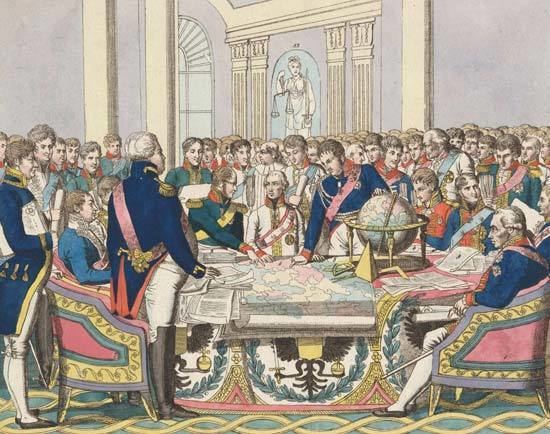 | ||
Similar | ||
The congress of vienna metternich s conservative order ap euro
The Congress of Vienna (German: Wiener Kongress) was a conference of ambassadors of European states chaired by Austrian statesman Klemens von Metternich, and held in Vienna from November 1814 to June 1815, though the delegates had arrived and were already negotiating by late September 1814. The objective of the Congress was to provide a long-term peace plan for Europe by settling critical issues arising from the French Revolutionary Wars and the Napoleonic Wars. The goal was not simply to restore old boundaries but to resize the main powers so they could balance each other off and remain at peace. The leaders were conservatives with little use for republicanism or revolution, both of which threatened to upset the status quo in Europe. France lost all its recent conquests, while Prussia, Austria and Russia made major territorial gains. Prussia added smaller German states in the west, Swedish Pomerania and 60% of the Kingdom of Saxony; Austria gained Venice and much of northern Italy. Russia gained parts of Poland. The new Kingdom of the Netherlands had been created just months before, and included formerly Austrian territory that in 1830 became Belgium.
Contents
- The congress of vienna metternich s conservative order ap euro
- History short the congress of vienna
- Preliminaries
- Participants
- Four Great Powers and Bourbon France
- Other signatories of the Treaty of Paris 1814
- Others
- Talleyrands role
- Polish Saxon crisis
- Final Act
- Other changes
- Later criticism
- References
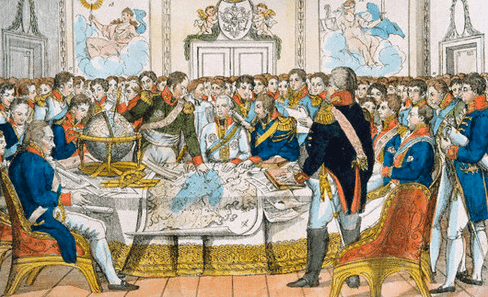
The immediate background was Napoleonic France's defeat and surrender in May 1814, which brought an end to twenty-five years of nearly continuous war. Negotiations continued despite the outbreak of fighting triggered by Napoleon's dramatic return from exile and resumption of power in France during the Hundred Days of March–July 1815. The Congress's "Final Act" was signed nine days before his final defeat at Waterloo on 18 June 1815.
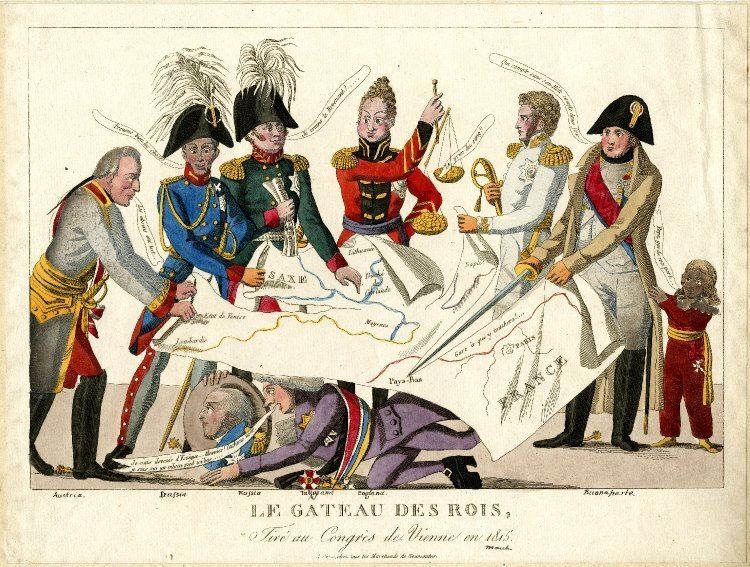
The Congress has often been criticized for causing the subsequent suppression of the emerging national and liberal movements, and it has been seen as a reactionary movement for the benefit of traditional monarchs. However, others praise it for having created relatively long-term stable and peaceful conditions in most of Europe.
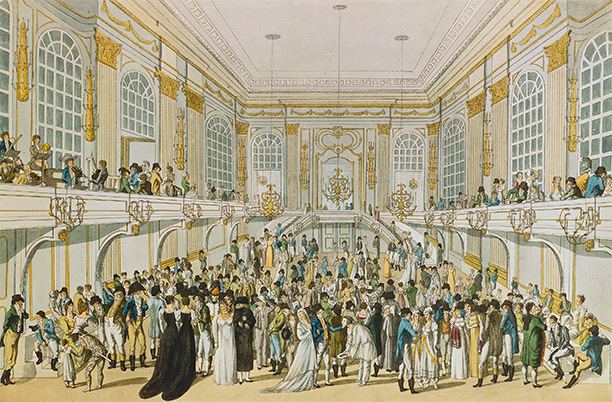
In a technical sense, the "Congress of Vienna" was not properly a Congress: it never met in plenary session, and most of the discussions occurred in informal, face-to-face, sessions among the Great Powers of Austria, Britain, France, Russia, and sometimes Prussia, with limited or no participation by other delegates. On the other hand, the Congress was the first occasion in history where, on a continental scale, national representatives came together to formulate treaties, instead of relying mostly on messages between the several capitals. The Congress of Vienna settlement, despite later changes, formed the framework for European international politics until the outbreak of the First World War in 1914. Major points of the Treaty of Vienna were ☆The Bourbon dynasty, which had been deposed during the French Revolution, was restored to power. ☆France lost the territories it had annexed under Napoleon. ☆A series of states were set up on the boundaries of France to prevent its expansion in future. Thus, the kingdom of the Netherlands, which included Belgium, was set up in the North and Genoa was added to Piedmont in the South. ☆Prussia was given important new territories on its Western frontiers, while Austria was given control of Northern Italy. ☆German confederation of 39 states that had been set up by Napoleon was left untouched. ☆In the East, Russia was given part of poland while Prussia was given a portion of Saxony
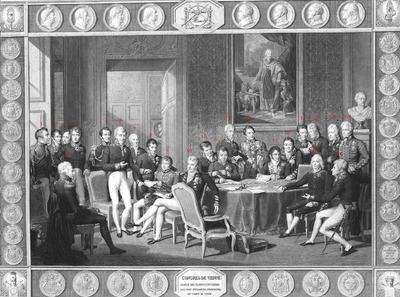
History short the congress of vienna
Preliminaries
The Treaty of Chaumont in 1814 had reaffirmed decisions that had been made already and which would be ratified by the more important Congress of Vienna of 1814–15. They included the establishment of a confederated Germany, the division of Italy into independent states, the restoration of the Bourbon kings of Spain, and the enlargement of the Netherlands to include what in 1830 became modern Belgium. The Treaty of Chaumont became the cornerstone of the European Alliance which formed the balance of power for decades. Other partial settlements had already occurred at the Treaty of Paris between France and the Sixth Coalition, and the Treaty of Kiel which covered issues raised regarding Scandinavia. The Treaty of Paris had determined that a "general congress" should be held in Vienna, and that invitations would be issued to "all the Powers engaged on either side in the present war." The opening was scheduled for July 1814.
Participants
The Congress functioned through formal meetings such as working groups and official diplomatic functions; however, a large portion of the Congress was conducted informally at salons, banquets, and balls.
Four Great Powers and Bourbon France
The Four Great Powers had previously formed the core of the Sixth Coalition. On the verge of Napoleon's defeat they had outlined their common position in the Treaty of Chaumont (March 1814), and negotiated the Treaty of Paris (1814) with the Bourbons during their restoration:
Other signatories of the Treaty of Paris, 1814
These parties had not been part of the Chaumont agreement, but had joined the Treaty of Paris (1814):
Others
Virtually every state in Europe had a delegation in Vienna – more than 200 states and princely houses were represented at the Congress. In addition, there were representatives of cities, corporations, religious organizations (for instance, abbeys) and special interest groups – e.g., a delegation representing German publishers, demanding a copyright law and freedom of the press. The Congress was noted for its lavish entertainment: according to a famous joke it did not move, but danced.
Talleyrand's role
Initially, the representatives of the four victorious powers hoped to exclude the French from serious participation in the negotiations, but Talleyrand skillfully managed to insert himself into "her inner councils" in the first weeks of negotiations. He allied himself to a Committee of Eight lesser powers (including Spain, Sweden, and Portugal) to control the negotiations. Once Talleyrand was able to use this committee to make himself a part of the inner negotiations, he then left it, once again abandoning his allies.
The major Allies' indecision on how to conduct their affairs without provoking a united protest from the lesser powers led to the calling of a preliminary conference on protocol, to which Talleyrand and the Marquis of Labrador, Spain's representative, were invited on 30 September 1814.
Congress Secretary Friedrich von Gentz reported, "The intervention of Talleyrand and Labrador has hopelessly upset all our plans. Talleyrand protested against the procedure we have adopted and soundly [be]rated us for two hours. It was a scene I shall never forget." The embarrassed representatives of the Allies replied that the document concerning the protocol they had arranged actually meant nothing. "If it means so little, why did you sign it?" snapped Labrador.
Talleyrand's policy, directed as much by national as personal ambitions, demanded the close but by no means amicable relationship he had with Labrador, whom Talleyrand regarded with disdain. Labrador later remarked of Talleyrand: "that cripple, unfortunately, is going to Vienna." Talleyrand skirted additional articles suggested by Labrador: he had no intention of handing over the 12,000 afrancesados – Spanish fugitives, sympathetic to France, who had sworn fealty to Joseph Bonaparte, nor the bulk of the documents, paintings, pieces of fine art, and books that had been looted from the archives, palaces, churches and cathedrals of Spain.
Polish-Saxon crisis
The most dangerous topic at the Congress was the so-called Polish-Saxon Crisis. Russia wanted most of Poland, and Prussia wanted all of Saxony, whose king had allied with Napoleon. The tsar would become king of Poland. Austria was fearful this would make Russia much too powerful, a view which was supported by Britain. The result was deadlock, for which Talleyrand proposed a solution: Admit France to the inner circle, and France would support Austria and Britain. The three nations signed a secret treaty on 3 January 1815, agreeing to go to war against Russia and Prussia, if necessary, to prevent the Russo-Prussian plan from coming to fruition.
When the tsar heard of the secret treaty he agreed to a compromise that satisfied all parties on 24 October 1815. Russia received most of the Napoleonic Duchy of Warsaw as a "Kingdom of Poland" – called Congress Poland, with the tsar as king ruling it independently of Russia. Russia, however, did not receive the province of Posen (Poznań), which was given to Prussia as the Grand Duchy of Posen, nor Kraków, which became a free city. Furthermore, the tsar was unable to unite the new domain with the parts of Poland that had been incorporated into Russia in the 1790s. Prussia received 60 percent of Saxony-later known as the Province of Saxony, with the remainder returned to King Frederick Augustus I as his Kingdom of Saxony.
Final Act
The Final Act, embodying all the separate treaties, was signed on 9 June 1815 (a few days before the Battle of Waterloo). Its provisions included:
The Final Act was signed by representatives of Austria, France, Portugal, Prussia, Russia, Sweden-Norway, and Britain. Spain did not sign the treaty but ratified it in 1817.
Other changes
The Congress's principal results, apart from its confirmation of France's loss of the territories annexed between 1795–1810, which had already been settled by the Treaty of Paris, were the enlargement of Russia, (which gained most of the Duchy of Warsaw) and Prussia, which acquired the district of Poznań, Swedish Pomerania, Westphalia and the northern Rhineland. The consolidation of Germany from the nearly 300 states of the Holy Roman Empire (dissolved in 1806) into a much less complex system of thirty-nine states (4 of which were free cities) was confirmed. These states formed a loose German Confederation under the leadership of Austria and Prussia.
Representatives at the Congress agreed to numerous other territorial changes. By the Treaty of Kiel, Norway had been ceded by the king of Denmark-Norway to the king of Sweden. This sparked the nationalist movement which led to the establishment of the Kingdom of Norway on May 17, 1814 and the subsequent personal Union with Sweden. Austria gained Lombardy-Venetia in Northern Italy, while much of the rest of North-Central Italy went to Habsburg dynasties (the Grand Duchy of Tuscany, the Duchy of Modena, and the Duchy of Parma).
The Papal States were restored to the Pope. The Kingdom of Piedmont-Sardinia was restored to its mainland possessions, and also gained control of the Republic of Genoa. In Southern Italy, Napoleon's brother-in-law, Joachim Murat, was originally allowed to retain his Kingdom of Naples, but his support of Napoleon in the Hundred Days led to the restoration of the Bourbon Ferdinand IV to the throne.
A large United Kingdom of the Netherlands was formed for the Prince of Orange, including both the old United Provinces and the formerly Austrian-ruled territories in the Southern Netherlands. Other, less important, territorial adjustments included significant territorial gains for the German Kingdoms of Hanover (which gained East Frisia from Prussia and various other territories in Northwest Germany) and Bavaria (which gained the Rhenish Palatinate and territories in Franconia). The Duchy of Lauenburg was transferred from Hanover to Denmark, and Prussia annexed Swedish Pomerania. Switzerland was enlarged, and Swiss neutrality was established. Swiss mercenaries had played a significant role in European wars for a couple of hundred years: the Congress intended to put a stop to these activities permanently.
During the wars, Portugal had lost its town of Olivença to Spain and moved to have it restored. Portugal is historically Britain's oldest ally, and with British support succeeded in having the re-incorporation of Olivença decreed in Article 105 of the Final Act, which stated that the Congress "understood the occupation of Olivença to be illegal and recognized Portugal's rights". Portugal ratified the Final Act in 1815 but Spain would not sign, and this became the most important hold-out against the Congress of Vienna. Deciding in the end that it was better to become part of Europe than to stand alone, Spain finally accepted the Treaty on 7 May 1817; however, Olivença and its surroundings were never returned to Portuguese control and this question remains unresolved. Great Britain received parts of the West Indies at the expense of the Netherlands and Spain and kept the former Dutch colonies of Ceylon and the Cape Colony as well as Malta and Heligoland. Under the Treaty of Paris, Britain obtained a protectorate over the United States of the Ionian Islands and the Seychelles.
Later criticism
The Congress of Vienna was frequently criticized by nineteenth-century and more recent historians for ignoring national and liberal impulses, and for imposing a stifling reaction on the Continent. It was an integral part in what became known as the Conservative Order, in which the liberties and civil rights associated with the American and French Revolutions were de-emphasized, so that a fair balance of power, peace and stability, might be achieved.
In the 20th century, however, many historians came to admire the statesmen at the Congress, whose work prevented another widespread European war for nearly a hundred years (1815–1914). Among these is Henry Kissinger, who in 1954 wrote his doctoral dissertation, A World Restored, on it. Historian Mark Jarrett argues that the Congress of Vienna and the Congress System marked "the true beginning of our modern era." He says the Congress System was deliberate conflict management, and was the first genuine attempt to create an international order based upon consensus rather than conflict. "Europe was ready," Jarrett states, "to accept an unprecedented degree of international cooperation in response to the French Revolution." Historian Paul Schroeder argues that the old formulae for "balance of power" were in fact highly destabilizing and predatory. He says the Congress of Vienna avoided them and instead set up rules that produced a stable and benign equilibrium. The Congress of Vienna was the first of a series of international meetings that came to be known as the Concert of Europe, which was an attempt to forge a peaceful balance of power in Europe. It served as a model for later organizations such as the League of Nations in 1919 and the United Nations in 1945.
Prior to the opening of the Paris peace conference of 1918, the British Foreign Office commissioned a history of the Congress of Vienna to serve as an example to its own delegates of how to achieve an equally successful peace. Besides, the main decisions of the Congress were made by the Four Great Powers and not all the countries of Europe could extend their rights at the Congress. The Italian peninsula became a mere "geographical expression" as divided into seven parts: Lombardy–Venetia, Modena, Naples–Sicily, Parma, Piedmont–Sardinia, Tuscany, and the Papal States under the control of different powers. Poland remained partitioned between Russia, Prussia and Austria, with the largest part, the newly created Kingdom of Poland, remaining under Russian control.
The arrangements made by the Four Great Powers sought to ensure future disputes would be settled in a manner that would avoid the terrible wars of the previous twenty years. Although the Congress of Vienna preserved the balance of power in Europe, it could not check the spread of revolutionary movements across the continent some 30 years later.
